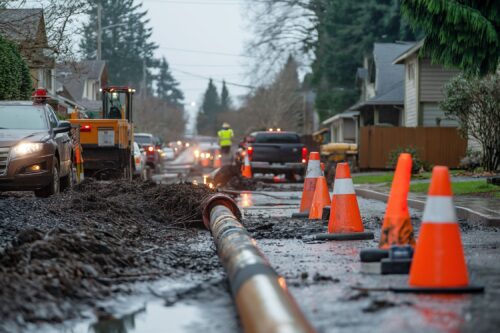
As states, cities, and utilities plan to meet decarbonization goals, electrification has emerged as a key strategy to reduce emissions from fuel combustion in buildings. However, widespread building electrification will pose a challenge for cost recovery on the gas system as fixed gas system costs are spread among fewer customers. Managing these costs will be crucial to limit rate impacts on remaining gas customers.
Non-pipeline alternatives (NPAs) are projects that enable gas utilities to avoid gas infrastructure investments and/or retire existing gas infrastructure through measures that reduce gas usage. Through E3’s research and client engagements, we have recognized an important insight: NPA opportunities fall into one of two categories, each with distinct planning requirements, measures, and implementation strategies. This binary classification can help structure how utilities, regulators, and stakeholders approach site identification, project evaluation, and program design.
We refer to these categories as Zero Gas NPAs and Demand Reduction NPAs:
|
Zero Gas NPAs |
Demand Reduction NPAs | |
|
Success Threshold |
Termination of gas service for all customers in project area |
Sufficient peak demand reduction to avoid or defer capacity upgrades |
|
Infrastructure Avoided |
Gas mains and services that deliver gas to end use customers |
Larger capacity investments; i.e., projects to meet peak gas demand and address supply constraints |
|
Geographic Scope |
Smaller: city block, set of blocks, or small neighborhood – at least for the near term |
Larger: neighborhood, city, or even larger area |
|
Key Measures |
Only includes measures that can eliminate gas usage. This includes building electrification, networked geothermal, and delivered fuels (e.g., propane) |
Also includes measures that reduce peak gas demand. This includes electrification, networked geothermal, and delivered fuels, plus building shell improvements, efficient gas equipment, demand response / interruptible tariffs, and alternative fuel supply |
|
Challenges |
Requires full customer opt-in or utility flexibility to retire gas service |
Requires sustained reductions in demand; must overcome growth trends in some areas |
Example: Zero Gas NPA
In 2022, Pacific Gas and Electric Company (PG&E) proposed a Zero Gas NPA at the campus of California State University Monterey Bay. PG&E identified the gas distribution system serving CSU Monterey Bay as requiring near-term replacement. The proposed NPA project would fully electrify over 500 premises and would decommission the existing gas distribution infrastructure, with an estimated cost to ratepayers that would be less than the cost to replace the gas infrastructure. Although the project would electrify over 500 customers, the facilities are all owned by CSU – an arrangement that dramatically improves the feasibility of a Zero Gas NPA, as PG&E would not need the independent approval of each customer. The application stalled due to stakeholder disagreement regarding cost recovery for the NPA project.
Example: Demand Reduction NPA
In 2025, Xcel Energy Colorado filed an application for a Demand Reduction NPA called the Mountain Energy Project, a “hybrid portfolio solution to a gas supply constraint in the Company’s Eastern Mountain Gas System.” The proposed project is a portfolio of NPAs, including gas demand-side management measures, building electrification measures, and incremental gas supply from compressed natural gas and liquified natural gas. The application states that the goal of the project is “to reduce Design Day peak hour gas demand that is contributing to the existing and forecasted supply shortfall.” An active proceeding reviewing the application is currently underway at the Colorado Public Utilities Commission.
E3 has supported several high profile projects in the emerging field of NPAs that have helped inform the development of this framework:
- In 2022-2024, E3 led a California Energy Commission-funded research grant exploring eleven potential pilot projects for Targeted Electrification and Gas Decommissioning in Northern California. In this project, the E3-led team developed a site identification process, produced a site-specific benefit-cost analysis framework, engaged customers in the pilot communities, and drafted initial project deployment plans.
- This year, E3 supported Rhode Island Energy (RIE) by developing a technical and economic analysis of alternative measures to an existing liquified natural gas (LNG) vaporization facility in a capacity-constrained part of RIE’s service territory, Aquidneck Island.
- In 2024-2025, E3 supported the Massachusetts gas Local Distribution Companies (LDCs) in a stakeholder engagement process for the LDCs’ draft NPA analysis framework, soliciting feedback on project identification, benefit-cost analysis, and implementation strategies.
E3 has supported other utilities across the country in conducting NPA potential, feasibility, and benefit cost analyses. While each regulatory context is different, we’ve found that distinguishing NPAs by function – zeroing out usage versus reducing peak – provides important framing for NPA projects early in the planning process.
To learn more about E3’s NPA work or request project-specific guidance, contact Dan Aas or Ari Gold-Parker.


